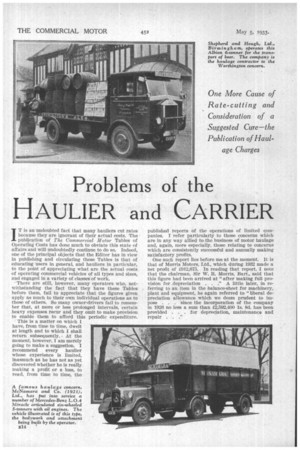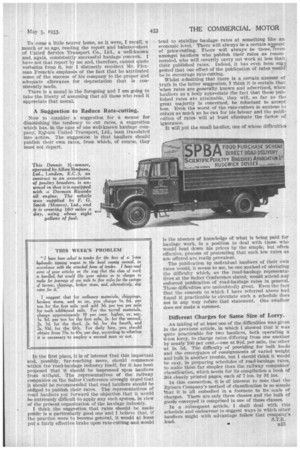Problems of the
Page 144

Page 145

If you've noticed an error in this article please click here to report it so we can fix it.
HAULIER and CARRIER IT is an undoubted fact that many hauliers cut rates because they are ignorant of their actual costs. The publication of The Commercial Motor Tables of Operating Costs has done much to obviate this state of affairs and will undoubtedly continue to do so. Indeed, one of the principal objects that the Editor has in view in publishing and circulating those Tables is that of educating users in general, and hauliers in particular, to the point of appreciating what are the actual costs. of operating commercial vehicles of all types and sizes, and engaged in a variety of classes of work.
There are still, however, many operators who, notwithstanding the fact that they have these Tables before them, fail to appreciate that the figures given apply as much to their OW11 individual operations as to those of others. So many owner-drivers fail to remember that, at more or less prolonged intervals, certain heavy expenses recur and they omit to make provision to enable them to afford this periodic expenditure.
This is a matter on which I have, from time to time, dwelt at length and to vvhich I shall return subsequently. • At the moment, however. I am merely going to make a suggestion. I recommend every haulier whose experience is limited, inasmuch as he has not as yet discovered whether he is really making a profit or a loss, to read, from time to time, the
published reports of the operations of limited companies. I refer particularly to those concerns which are in any way allied to the business of motor haulage and, again, more especially, those relating to concerns which are consistently successful and annually making satisfactory profits.
One such report lies before me at the moment. It is that of Morris Motors, Ltd., which during 1932 made a net profit of £912,675. In reading that report, I note that the chairman, Sir W. R. Morris, Bart., said that this figure had been arrived at "after making full pro
vision for ,depreciation . ." A little later, in referring to an item in the balance-sheet for machinery, plant and equipment, he again referred to "liberal depreciation allowance which we deem prudent to im
pose . since the incorporation of the company in 1926 no less a sum than £2,592,400 is. Sd. has been provided for depreciation, maintenanco and repair .
To come a little nearer home, as it were,, I recall, a month or so ago, reading the report and balance-sheet of United Service Transport Co., Ltd., a well-known and, again, consistently successful haulage. concern. I have not that report by me and, therefore, cannot quote verbatim from it, but I distinctly recollect Mr. Flexman French's emphasis of the fact that he attributed some of the success of his company to the proper and adequate allowance for depreciation that is consistently made.
There is a moral in the foregoing and I am going to take the liberty of assuming that all those who read it appreciate that moral.
A Suggestion to Reduce Rate-cutting.
Now to consider a suggestion for a means for diminishing the tendency to cut rates, a suggestion which has, in the case of one well-known haulage company, RNburn United Transport, Ltd., been translated into action. The suggestion is that hauliers should publish their own rates, from which, of course, they must not depart.
In the first place, it is of interest that this important and, possibly, far-reaching move, should commence within the road7haulage industry itself, for it has been proposed that it should he impressed -upon hauliers from without. The representatives of the railway companies on the Salter Conference strongly urged that it should be recommended that road hauliers should be obliged to publish their rates. The representatives of road hauliers put forward the objection that it would be extremely difficult to apply any such system, in view of the present organization of the haulage industry.
I think the suggestion that rates should be made public is a particularly good one and I believe that, if the practice were to become general, it would at least put a fairly effective brake upon rate-cutting and would
tend to stabilize haulage rates at something like an economic level.There will always be a certain amount of price-cutting. There will always be those, even amongst hauliers who publish their rates as recommended, who will covertly carry out work at less than their published rates. Indeed, it has even been suggested. that one effect of the publication of rates would be to encourage fate-cutting.
Whilst admitting that there is a certain amount of truth in the latter suggestion, I think it is certain that when rates are generally known and advertised, when hauliers as a body appreciate the fact that these published rates are attainable, they will, so far as the great majority is concerned, be reluctant to accept less. Even the worst of the rate-cutters is anxious to obtain as much as he can for his labour and the publication of rates will at least eliminate the factor of ignorance. It will put the small haulier, one of whose difficulties is the absence of knowledge of what is being paid for haulage work, in a position to deal with those who would heat down his prices by the simple, but often effective, process of pretending that such low rates as are offered are really prevalent.
The publication by individual hauliers of their own rates would, it seems to me, be one method of obviating the difficulty which, as the road-haulage representatives at the Salter Conference stated, would attend any enforced publication of road-haulage rates in general. Those difficulties are undoubtedly great. Even the fact that the concern to which I have referred above had found it practicable to circulate such a schedule does not in any way refute that statement. One swallow does not make a summer.
Different Charges for Same Size of Lorry.
An inkling of at least one of the difficulties Was given in the previous article, in which I showed that it was quite practicable for two hauliers, both operating a 6-ten lorry, to charge rates differing from one another by nearly 100 cent.—one at 9id. per mile, the other
• at is. lid. The difficulty of providing for bulk loads and the conveyance of consignments of varied weight and bulk is another trouble, but I should think it would be easy, in preparing schedules of road-haulage rates, to make them far simpler than the railway companies' classification, Which needs for its compilation a book of 364 closely printed pages, each of 7 ins. by 9i ins.
In this connection, it is of interest to note that the Ryburn Company's method of classification is so simple That it is all embodied in a footnote to its scale of Charges. There are only three classes and the bulk of goods conveyed is comprised in one of those classes. In a subsequent article, I shall deal with this schedule and endeavour to suggest ways in which other hauliersmight with advantage follow that company's .lead. • S.T.R. .
4.0 • B15




























































































































































































